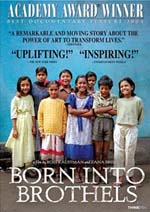Why Singapore’s English Teachers Should Embrace Singlish, Not Fight It
Is it time for Singaporean educators to embrace Singlish as a legitimate learning tool? What the Research […]
Read More
“I’m not a social worker. I’m not a teacher. And that’s my fear, that I can’t help them.”
 Born into Brothels: Calcutta’s Red Light Kids (2004) is an Oscar award-winning documentary that brings us a heartfelt look at life in the brothels of Calcutta. However, this story is told not from the perspective of the women but from that of eight children armed with eight instamatic cameras.
Born into Brothels: Calcutta’s Red Light Kids (2004) is an Oscar award-winning documentary that brings us a heartfelt look at life in the brothels of Calcutta. However, this story is told not from the perspective of the women but from that of eight children armed with eight instamatic cameras.
The story begins with Zana Briski, a New York-based photographer who entered the brothels hoping to photograph the lives of the prostitutes working there. In the process of doing so, she discovers that the brothels are not only inhabited by women but by their families as well. This includes dozens of children who play in the narrow alleyways even as customers come to engage their mothers’ services for the night.
Seeing how fascinated the kids were with her camera, Zana decides to start weekly photography workshops for eight children. Immediately, this becomes a means of expressing their frustrations, fears, and dreams of life beyond the brothels. And Zana begins to find herself moving from teaching principles of composition to finding ways to get these children into boarding schools outside the brothels.
The kids are well aware of where they stand in Indian society and for the girls, it is only a matter of time before they will be expected to follow in their mothers’ footsteps. As Koji, one of the kids in the film says, “The women ask me, ‘When are you going to join the line?’ They say it won’t be long.”
At first glance, Born into Brothels seems like a film that was made to make you feel guilty. The knowledge that the cost of your movie ticket is enough to sustain a whole family does make one uncomfortable.
Yet, what makes Born into Brothels special is that in spite of its bleak subject matter, the film maintains a pervasive sense of hope.
This documentary is also a wonderful learning resource that can teach students about human rights and the lives of children in difficult situations. Since the film, Zana has established a non-profit organisation that works towards helping other children empower themselves through art and photography. The film’s website provides teaching materials to help your students understand the children’s story.
More importantly, it is essentially a movie for teachers – especially those who have doubted their ability to make an impact on their students. Zana’s challenges and triumphs reminds us of the power of inspiring kids to go beyond their situations. As teachers, this is an opportunity we have every day and this film is a great way to jolt ourselves from the daily grind of covering the syllabus.